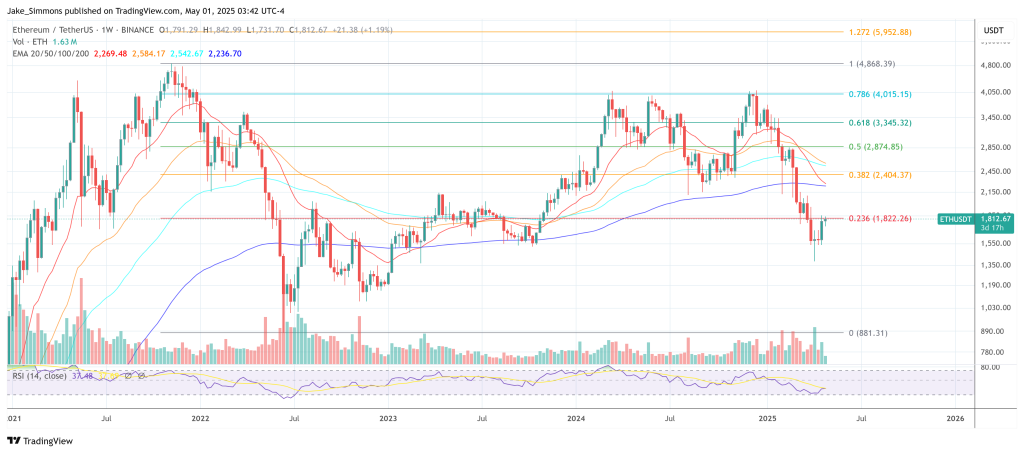Ethereum Basis researcher Dankrad Feist has cautioned that ETH’s base layer might slip into irrelevance inside a decade except the neighborhood embraces a much more aggressive roadmap for on-chain scaling and protocol overhaul. Writing in a put up on the Ethereum Magicians discussion board, Feist introduces a draft EIP that may pre-commit the community to a multi-year schedule of sharp gas-limit will increase and complementary architectural modifications.
“I do suppose it’s time for being unconventional, as a result of the present method of doing issues is more likely to make Ethereum irrelevant over the following 5-10 years,” Feist argues on the outset of his proposal.
Feist’s major concern is strategic. He insists that the principle chain should stay “the financial heart of Ethereum,” warning that splintering liquidity throughout an increasing constellation of Layer 2 networks threatens the platform’s aggressive place. “If L1 is unimportant and loses its attraction of liquidity and DeFi, there may also be much less of a motive for L2s to even stay connected to Ethereum,” he writes, including that rival ecosystems are “desperate to get its market share” exactly by providing high-throughput, single-layer consumer experiences.
What Wants To Change For Ethereum?
On the technical entrance, the researcher factors to speedy progress in zero-knowledge validity proofs: “Proving Ethereum L1 blocks grew to become first doable, and is now low cost,” he notes, citing a present per-block proof price of just a few cents through publicly accessible dashboards. In accordance with Feist, the ecosystem is on observe to attain single-slot proof latency later this 12 months, whereas data-availability sampling (DAS) by the PeerDAS initiative “may also turn into actuality.” Collectively, these breakthroughs open the door to “100x to 1000x the present scale whereas holding an important properties: verifiability and censorship resistance.”
Feist highlights that Ethereum’s node structure nonetheless mirrors Bitcoin’s 2009 design, asserting that it should evolve into differentiated roles—some lighter than right this moment’s full nodes, others “beefy” builders or provers working below a one-out-of-n honesty assumption. “The important thing to sustaining safety and holding Ethereum unstoppable [is] that every one node varieties can nonetheless be run from dwelling in some locations,” he writes, referencing analysis calls led by Ethereum Basis colleague Barnabé Monnot.
Traditionally, Ethereum governance has most well-liked incrementalism, however Feist contends that timidity now courts obsolescence. “Working backwards from a aim tends to have higher outcomes than making incremental modifications as they turn into doable,” he says, calling for hard-coded targets reasonably than open-ended deliberation. Below his define, the forthcoming Glamsterdam improve would prioritise delayed execution, shorter slot occasions, and “aggressive historical past expiry.” Subsequent forks over the following two years would add parallel transaction execution, erasure-coded blocks, an enshrined zkEVM, execution payloads inside blobs, and the FOCIL mechanism to shore up censorship resistance.
Feist stresses that efficiency engineering should accompany consensus-layer work: “Having a concrete aim in thoughts will allow us to prioritise this work in addition to the concrete upgrades as wanted.” Databases and mempools optimised for a five-fold throughput improve, he causes, might look “very totally different” from these designed for a hundredfold bounce.
Anticipating criticism {that a} high-throughput roadmap would flip Ethereum right into a “datacenter chain,” Feist dismisses the label as superficial. “The core worth proposition of Ethereum shouldn’t be the house staker, it’s verifiability and censorship resistance,” he contends. Whereas acknowledging that the majority customers already depend on custodial RPC endpoints reasonably than self-run nodes, he argues that zero-knowledge proof verification will make trust-minimised utilization simpler, not tougher. Furthermore, mechanisms resembling FOCIL or Minimal Censorship Proposers (MCP) might ship “higher censorship resistance than we’ve right this moment.”
Feist closes by underscoring Ethereum’s “big moat in DeFi liquidity” and insists that colocated functions nonetheless derive community results from Layer 1 proximity. “At 100x the present scale, Ethereum L1 can help a really giant vary of value-transaction[s] such that competing with it merely on scaling phrases shouldn’t be an fascinating sport to play anymore,” he writes. The “endgame,” in his imaginative and prescient, is a base layer able to processing orders of magnitude extra exercise with out sacrificing the protocol’s defining ensures.
“We have to decide to it as quickly as doable, each as a result of builders and functions want predictability, and since we have to prioritise correctly in order that it will probably really get executed.”
At press time, ETH traded at $1,812.

Featured picture created with DALL.E, chart from TradingView.com

Editorial Course of for bitcoinist is centered on delivering completely researched, correct, and unbiased content material. We uphold strict sourcing requirements, and every web page undergoes diligent evaluation by our staff of high expertise consultants and seasoned editors. This course of ensures the integrity, relevance, and worth of our content material for our readers.








